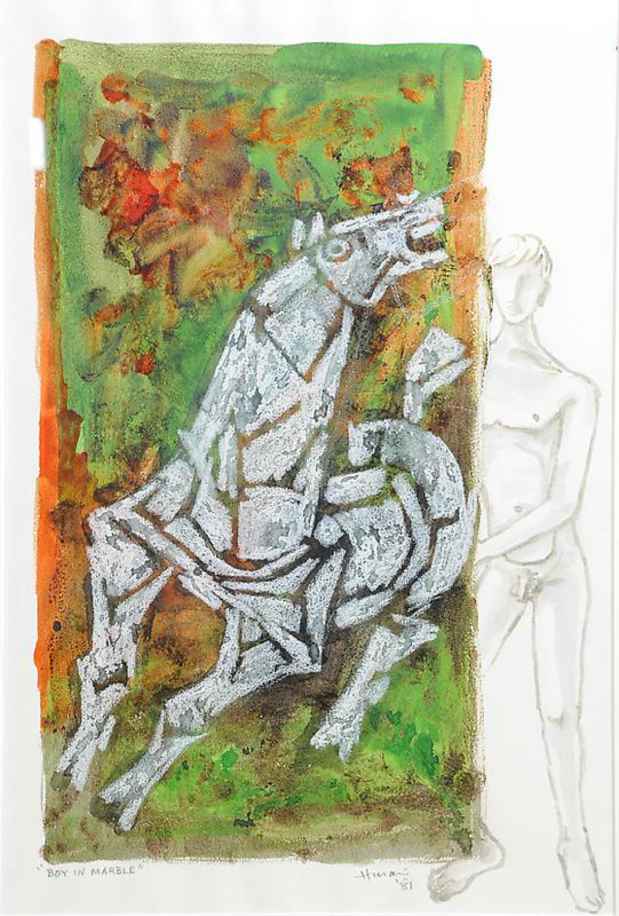"POP - Progressives on Paper" Exhibition
Aicon Gallery

This event has ended.
Aicon Gallery presents POP, Part one of a two-part exhibition featuring master-works by the leaders of India’s Progressive Artists Group. Part one of this exhibition will focus on a selection of works on paper from M. F. Husain, Ram Kumar, Akbar Padamsee, S. H. Raza, and F. N. Souza. Part two of the exhibition will feature a stunning array of works on canvas by these and other Progressive masters and will open this coming September at Aicon New York. Both exhibitions are dedicated to the memory of M. F. Husain, a friend and inspiration to us all.
Founded in the years immediately following India’s independence by M. F. Husain, F. N. Souza, S. H. Raza and others, the Bombay Progressive Artists Group grew to become the most influential group of modern artists in India. The artists at the core of this group sought new forms of expression to capture and convey India’s complex past and its emerging post-colonial reality. By combining distinctly Indian subject matter with Post-Impressionist colors, Cubist forms and Expressionistic gestures, these artists forged a synthesis between early European modernist techniques and the ever shifting cultural and historical identities of India. The Group also sought to break with the revivalist nationalism established by the Bengal School of Art, opting instead to paint with absolute freedom over content and technique, as their internationalist desires combined with the need to represent and belong to their homeland. Although the Progressive Artists Group disbanded in 1956, its leading artists continued to cultivate their individual styles and remain an influence and inspiration for multiple generations of contemporary South Asian artists.
Regarded as the “Picasso of India,” M. F. Husain, to whom this exhibition is dedicated, is arguably the most recognizable figure of modern and contemporary Indian art. His narrative works, executed in a modified Cubist style, can be caustic and funny as well as serious and somber. His themes, usually treated in series, also include hallmarks of Indian culture and history, such as the Ramayana, the Mahabharata, the British Empire, and motifs of Indian urban and rural life. His use of folk, tribal, religious and mythological icons, such as Mother Teresa, Gandhi, Krishna and Saraswati, are characteristic to his work, revealing his penchant for blending diverse cultural influences.
An iconoclast known for his powerful imagery and the Group’s main ideologue, F. N. Souza’s unrestrained graphic style and uncompromising vision created much controversy surrounding his life and work. His repertoire of subjects covers still life, landscape, nudes and icons of Christianity, rendered boldly in a frenzied distortion of form. Souza's works express defiance and impatience with convention and the banality of everyday life. A recurrent theme in his work is the sexual tensions and conflict within male-female relationships. In his drawings, Souza uses a masterful economy of line to provide the fine detail in his forms while bringing forth the complex emotional underpinnings of his subjects.
The frenetic abstract works of Ram Kumar have served to consistently set his work apart from the more simplistic narratives that have developed around modern Indian art. Indeed, by insisting on the abstract, Kumar demands something that most of his contemporaries do not; a private, contemplative viewing experience. His works are often less about transcendence, and more about the visual encounter between the viewer and the painting in front of them. Thus, Kumar’s evolution from his earlier figurative work to the abstract landscapes seen in this exhibition can be understood as the embodiment of a break between depicting something (the individual) and articulating the possible response of that something; between looking at a picture and participating in it.
Since his work with the Progressive Artists Group, S. H. Raza’s subject, style and technique have evolved over distinct stages, drawing influence from his migration to France, his involvement with Abstract Expressionism in the 1950s and 1960s, and ultimately his return to a core Indian aesthetic philosophy in the 1970s. Breaking away from specific locations in time and space, or the confines of a nationalistic focus, his body of work is trans-cultural in its appeal, proving Raza an especially significant Indian artist on a worldwide stage.
Similarly, Akbar Padamsee’s work ranges from figurative, to non-representational and abstract, making him an artist difficult to bracket. In fact for Padamsee, it not the bracketing which is of consequence, for his main pre-occupation is with the form, volume, space, time and color. He is very conscious of every mark that he makes; the process of creation is one of contemplation and articulation of thoughts and ideas. The figures in his watercolors presented here are on the surface both real and transcendent, as they carry both an expression of effable sadness and a refined sense of grace.
Although all well known for their distinctive, often monumental, works on canvas, the first installment of this two-part exhibition focuses exclusively on works on paper by these five masters of Modern Indian art and features work in a wide range of media, from watercolor to photography. It can be said, and indeed seen, that each of these artists considered their works on paper not merely as a staging ground for larger-scale canvases, but as fully developed pictures in and of themselves, through which they sought to achieve a greater degree of experimentation and freedom in their distinctive, and now iconic, pictorial languages. Part Two of this exhibition, featuring a selection of large scale master-works on canvas, will open at Aicon New York in September, 2011.
[Image: M. F. Husain "BOY IN MARBLE" (1981) Watercolor and mixed media on paper, 17 x 11 in.]
Media
Schedule
from July 21, 2011 to August 13, 2011
Opening Reception on 2011-07-21 from 18:00 to 21:00
Artist(s)
M. F. Husain, Ram Kumar, Akbar Padamsee, S. H. Raza, F. N. Souza